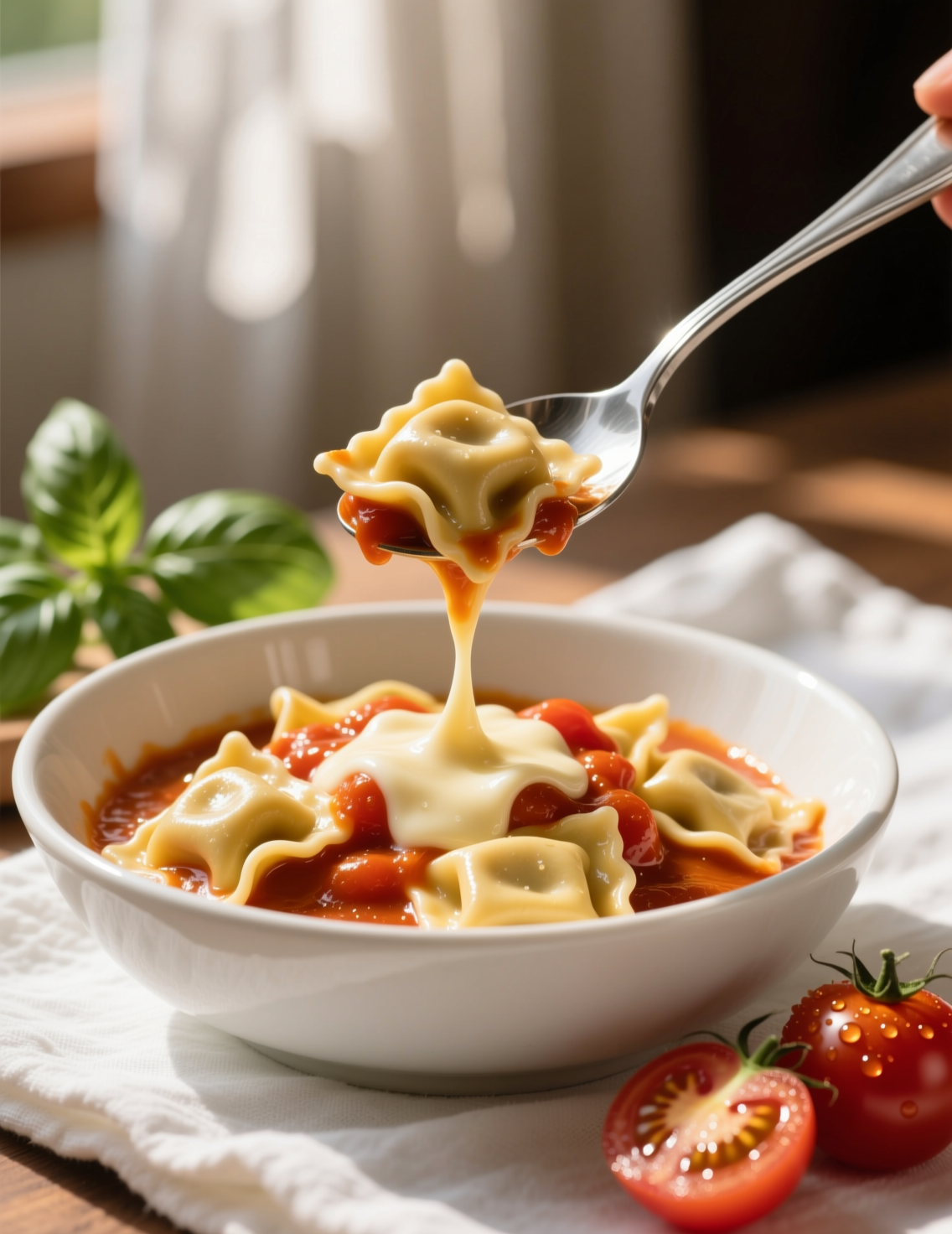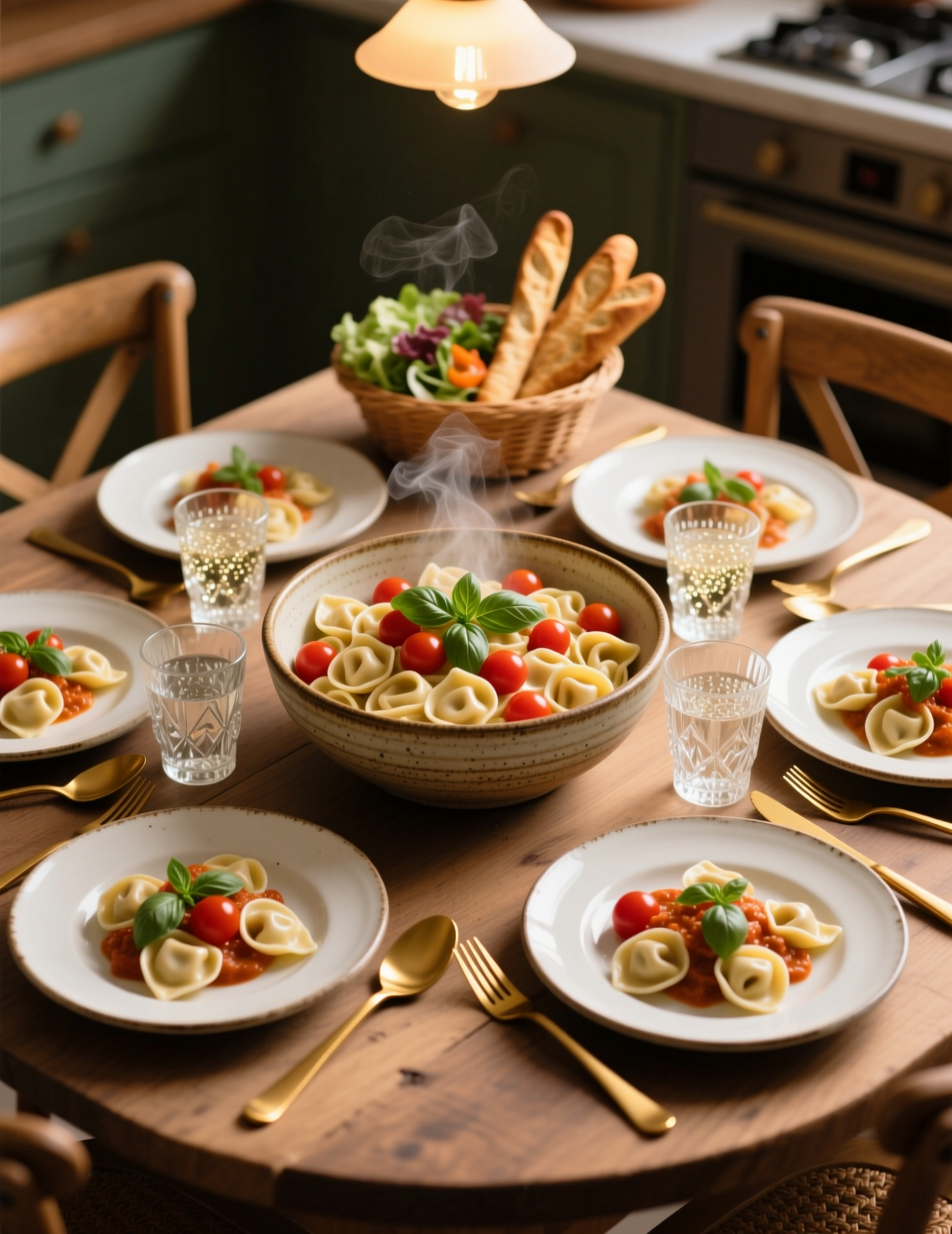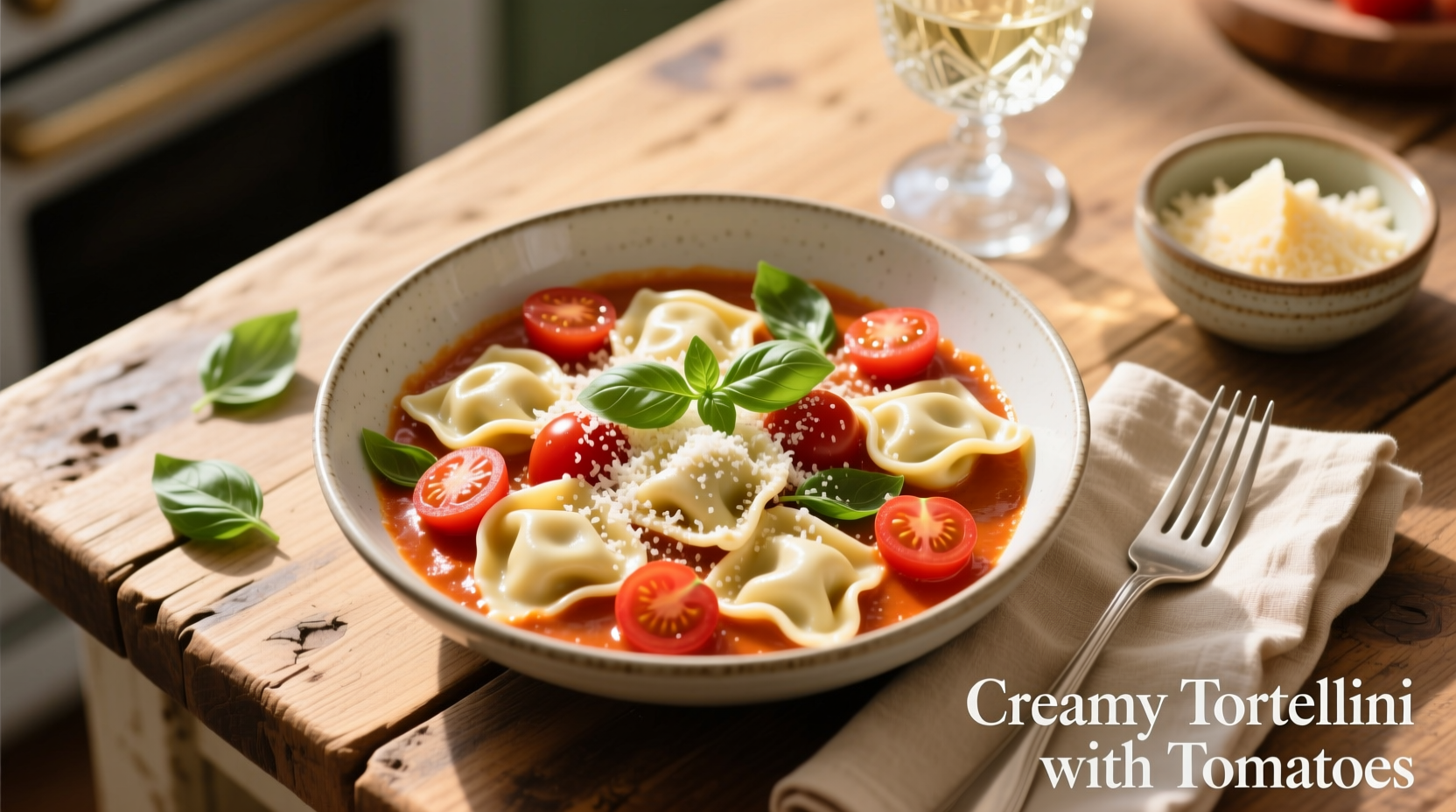There’s something quietly poetic about a dish that takes humble ingredients—pasta, tomatoes, cream—and turns them into a small miracle. Creamy Tortellini with Tomatoes is one of those deceptively simple recipes that feels like a warm hug after a long day, yet it also holds enough complexity for a seasoned chef to admire. This isn’t just about pasta and sauce; it’s about balancing texture, acidity, and fat until every bite feels effortless.
The Magic of Simplicity
Tortellini, often stuffed with cheese or meat, already brings richness to the table. Add in ripe cherry tomatoes and a touch of cream, and suddenly, you’ve got something both rustic and elegant. Professional kitchens often chase complexity—foams, reductions, emulsions—but this dish is proof that restraint is an art form too.
Good cooking isn’t about doing more. It’s about doing just enough. That’s what this recipe captures so beautifully.
Why This Dish Works
Let’s break this down like pros. Tortellini provides chew and structure. Tomatoes give acidity and brightness, cutting through the cream’s heaviness. Garlic and herbs bridge the two, creating that rounded, mouth-coating flavor you can’t quite explain but always crave.
If you’ve ever wondered why some creamy pasta dishes taste flat, it’s usually because the acid is missing. The tomato’s natural tang corrects that imbalance like a whisper in the ear of a lazy sauce.
Ingredient Breakdown
Here’s what you’ll need for 6 servings. These aren’t just ingredients; they’re decisions. Each one has a purpose.
- 2 tablespoons olive oil (use a fruity one if possible)
- 3 cloves garlic, finely minced
- 2 cups cherry tomatoes, halved
- 1 cup heavy cream
- 1 cup grated Parmesan (fresh, please—not the powdery stuff)
- 1 pound cheese tortellini (fresh or refrigerated)
- 1 tablespoon unsalted butter
- 1 teaspoon crushed red pepper flakes (optional, but try it once)
- Salt and freshly cracked black pepper to taste
- A handful of fresh basil leaves, torn
- ½ teaspoon lemon zest (small touch, big difference)
Now, these may look like basic pantry staples, but the interplay between them—fat, acid, umami, heat—makes the difference between “good” and “wow, who made this?”

The Cooking Process
Start by heating olive oil in a large skillet over medium heat. When the oil shimmers slightly (that’s how you know it’s ready), toss in the garlic. Let it sizzle just long enough to perfume the air, but not brown—it turns bitter fast.
Throw in your cherry tomatoes. They’ll hiss, release juice, and soften into this gorgeous, jammy consistency. Let them blister; don’t rush them. This caramelization is flavor development, not just aesthetics.
Meanwhile, cook your tortellini in well-salted water. Think of pasta water as the sea—salty enough that you could almost taste it. You’re not just seasoning the pasta; you’re building flavor into the dough itself.
Once the tomatoes are softened, pour in the heavy cream. Stir gently. The sauce will start to thicken, coat the back of a spoon, and feel velvety. Add the butter now—because fat carries flavor, and that small bit of extra richness gives the sauce a lush texture.
Fold in the cooked tortellini directly from the pot (don’t rinse!). The starch on the pasta helps the sauce cling like a secret handshake. Sprinkle in Parmesan, then stir until everything becomes creamy, glossy, and irresistibly tangled.
Finish with basil and lemon zest. That’s the high note—fresh and aromatic—that lifts the dish from comforting to memorable.
The Science Behind the Sauce
Cream sauces are a tricky beast. Too much heat, and they split. Too little, and they never thicken. What happens in the pan is a delicate emulsification between fat (cream, butter, cheese) and water (from tomatoes and pasta).
At around 180°F, cream begins to thicken due to fat globule stabilization. Parmesan cheese, rich in casein proteins, strengthens that network, giving you a sauce that hugs rather than slides off the pasta. Professional chefs often talk about “nappe consistency”—that smooth, coat-the-spoon texture. That’s your sign you’ve nailed it.
And that lemon zest? It introduces volatile oils that cut through fat at a molecular level, refreshing the palate. A tiny tweak, scientifically justified.
Professional Insights
In restaurant kitchens, a dish like this often plays the role of a quiet showstopper. It doesn’t shout, but it wins hearts. The trick is control. Over-seasoning, over-reducing, or over-simmering can flatten the sauce’s brightness.
Many chefs swear by roasting the tomatoes first for deeper flavor. The caramelization adds umami complexity. You can try that if you want more intensity, though pan-blistered tomatoes give a fresher, more vibrant result.
Another pro move? Finish the dish off the heat. Letting the tortellini rest in the sauce for a few minutes helps it absorb flavor without breaking down the emulsion.
Common Mistakes (and Fixes)
1. Sauce too thin?
Simmer a little longer or add a bit more Parmesan. The cheese helps bind it.
2. Sauce too thick?
Add a splash of reserved pasta water—liquid gold, rich in starch—to loosen it.
3. Lacking flavor?
Check your salt. Cream dulls flavors slightly, so seasoning at the end is key.
4. Tomatoes taste sour?
They might’ve been underripe. A pinch of sugar balances acidity without turning the dish sweet.
The Role of Quality Ingredients
You can’t fake freshness. Use ripe tomatoes, real cream, and freshly grated cheese. Industrial Parmesan doesn’t melt well—it clumps. Fresh cheese melts evenly, emulsifying into the sauce like silk.
For tortellini, fresh pasta is ideal. It cooks quickly, retains bite, and releases starch gradually. If you’re using dried, adjust the timing, and maybe add a touch more cream.
Variations Worth Trying
This base recipe is a canvas. Professionals often play with it depending on the season or service style.
- Add Protein: Grilled chicken, pancetta, or even seared shrimp fold in beautifully.
- Play with Greens: Spinach or arugula stirred in at the end add freshness and a slight bitterness that cuts the cream.
- Herbal Twists: Thyme or oregano gives a more Mediterranean touch.
- Vegan Version: Use cashew cream and vegan cheese substitutes—texture’s surprisingly close if done right.
Experimentation is the chef’s playground. Just remember balance—fat, acid, salt, heat. That’s the holy quartet.
Texture and Presentation
Texture is everything in professional plating. The tortellini should look plump, glossy, and perfectly coated—not drowning. A few torn basil leaves scattered over the top give contrast. A drizzle of olive oil adds sheen.
Serve it in wide, shallow bowls—it allows the sauce to pool just slightly, inviting a swirl of fork and spoon. It’s not just about how it tastes, but how it feels to eat.

Pairing and Serving Suggestions
This dish pairs beautifully with crisp white wines like Pinot Grigio or Sauvignon Blanc—the acidity balances the creaminess. If you’re serving a full meal, start with a light salad (something lemony, maybe with shaved fennel) and end with a clean dessert like sorbet or panna cotta.
Garlic bread? Optional. But if you serve it, make sure it’s crisp enough to scoop up that last spoon of sauce. Waste not a drop.
Emerging Trends and Culinary Context
Creamy pasta dishes have been reinventing themselves in modern kitchens. Plant-based alternatives are gaining traction, and chefs are exploring hybrid sauces—think tomato-cream miso fusions or smoky paprika cream bases.
Interestingly, global data from Google Trends shows a 30% rise in searches for “creamy tomato pasta” since 2020, particularly in colder months. It’s comfort food that adapts—affordable, scalable, and visually stunning for social media plating.
In fine dining, chefs use micro-tomatoes and infused oils to elevate presentation. At home, simplicity remains its charm. Food scientists, like Harold McGee, often point out that cream-based sauces work best when flavors are “layered, not stacked”—meaning gradual addition of components yields deeper complexity.
Nutritional Insights
Yes, it’s creamy. But moderation is the name of the game. Each serving roughly offers around:
- Calories: 580
- Protein: 20g
- Carbs: 45g
- Fat: 32g
Balance it with lean proteins and greens if you’re calorie-conscious. Use light cream if you prefer—but note, it may not thicken as beautifully.
Expert Recommendation
If you want to push this dish toward Michelin-level, focus on refinement. Infuse your cream with roasted garlic or basil stems before adding it to the sauce. The result? A subtle, infused depth that hints rather than declares.
Another tip: flash-chill your cooked tortellini before tossing in sauce, then reheat gently in it. This locks the filling inside and prevents overcooking—especially useful in service where timing matters.
Final Thoughts
Creamy Tortellini with Tomatoes isn’t just another weeknight dinner. It’s a masterclass in harmony. Every spoonful reminds you that food doesn’t need fireworks to impress—it just needs balance, care, and a touch of intuition.
Cooking at its best is both science and soul. This dish stands at that intersection beautifully. It’s simple enough to make at home, refined enough to serve in a restaurant, and comforting enough to crave again tomorrow.
And if you ever doubt your technique mid-cook, just remember: flavor lives in the small moments. In that second you decide not to rush the tomatoes. In the extra minute you let the sauce rest. That’s where great cooking hides—quietly, confidently, between the lines.
FAQs
What type of tortellini works best for this recipe?
Cheese-filled fresh tortellini works best as it balances beautifully with the creamy tomato sauce.
Can I use canned tomatoes instead of fresh cherry tomatoes?
Yes, but use high-quality canned San Marzano tomatoes for the best flavor and texture.
How can I make this dish vegetarian-friendly?
It’s already vegetarian—just ensure your Parmesan is made without animal rennet.
Can I substitute heavy cream with something lighter?
Yes, use half-and-half or light cream, but the sauce may be less rich and slightly thinner.
What wine pairs well with creamy tortellini with tomatoes?
A crisp white wine like Pinot Grigio or Sauvignon Blanc pairs perfectly.
Can I add meat to this recipe?
Absolutely, grilled chicken, pancetta, or shrimp blend beautifully with the sauce.
How long does creamy tortellini last in the fridge?
It lasts up to 3 days in an airtight container—just reheat gently to avoid curdling.
Can I freeze this dish?
Not recommended, as cream sauces tend to separate when frozen and reheated.
How can I make the sauce thicker?
Simmer it a bit longer or add more Parmesan cheese for extra body.
What’s the secret to a smooth, creamy sauce?
Avoid high heat and stir constantly to maintain a stable emulsion between cream and fat.
Can I add vegetables to this recipe?
Yes, spinach, arugula, or roasted bell peppers add great color and freshness.
Why is my sauce too sour?
Your tomatoes might be underripe—add a small pinch of sugar to balance the acidity.
How do I prevent the cream from curdling?
Use low to medium heat and never let it boil after adding the cream.
Can I make this dish vegan?
Yes, substitute cashew cream and vegan cheese alternatives for dairy ingredients.
What’s the best way to reheat creamy tortellini?
Warm it slowly on low heat, adding a splash of milk or cream to restore smoothness.

Mariana is a passionate home cook who creates delicious, easy-to-follow recipes for busy people. From energizing breakfasts to satisfying dinners and indulgent desserts, her dishes are designed to fuel both your body and hustle.
When she’s not in the kitchen, she’s exploring new flavors and dreaming up her next recipe to share with the Foodie Hustle community.

